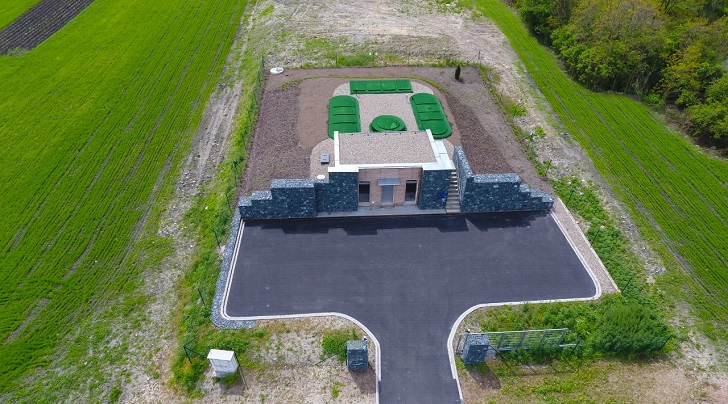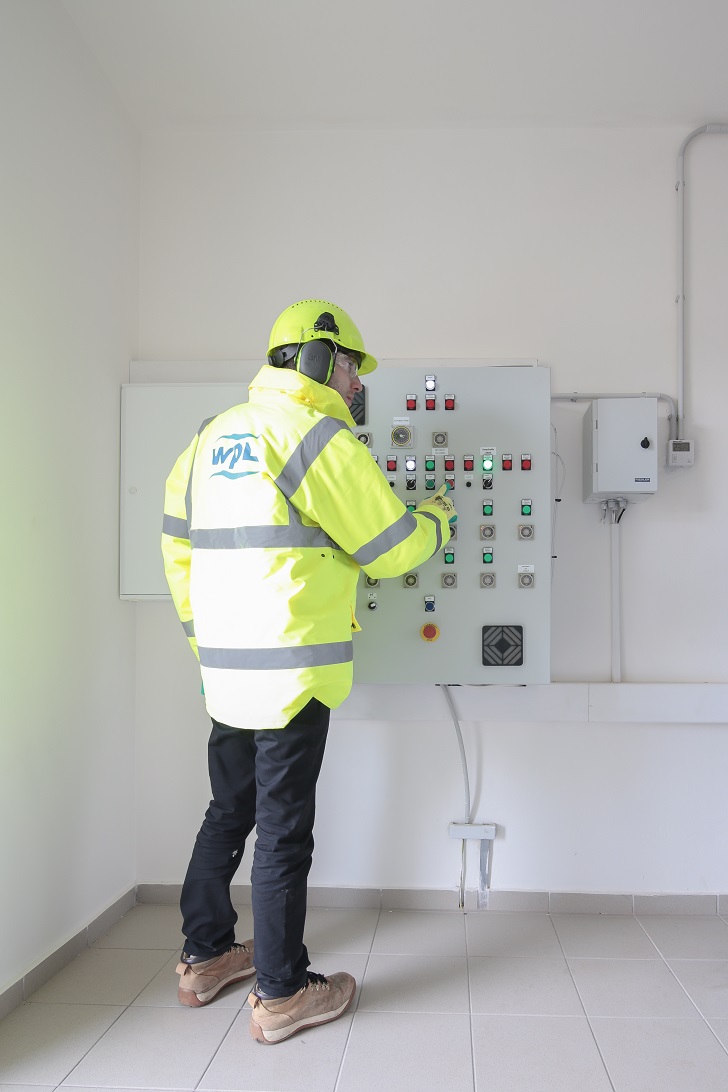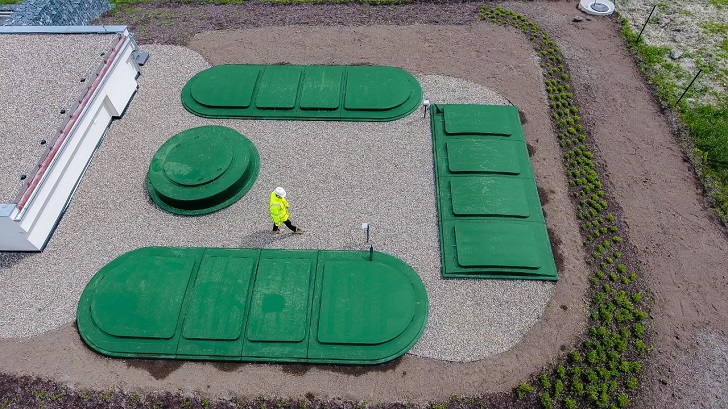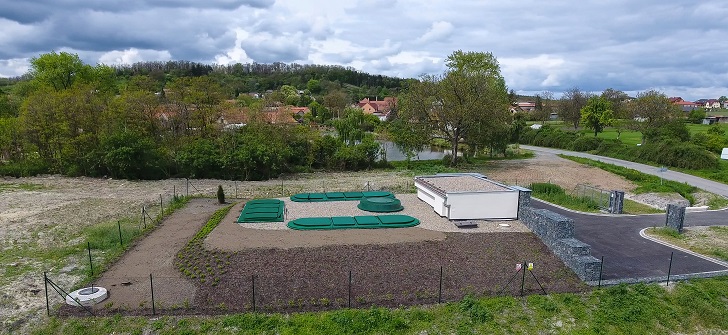



An innovative approach to the installation of a WPL HiPAF wastewater treatment system in the Czech Republic has cut costs, allowing for greater investment in site landscaping and design. The packaged plant, which has been installed in the village of Dřínov, includes a submerged aerated filter (SAF).
The four-unit modular system is part of a £1.2 m municipal sewerage scheme to help clean up the environment in Mělník District, 30 km north of Prague. The centralization of wastewater collection and redundancy of poorly maintained septic tanks is expected to raise the quality of local surface waters significantly.
The high-performance aerated filter (HiPAF) was designed and manufactured by UK packaged treatment specialist WPL. It was specified by the Dřínov municipality’s engineering consultant prior to tender and is designed to serve 620 people. To meet rigorous environmental standards and budgetary targets, WPL carefully scrutinized a range of measures including installation technique, maintenance requirement and real-time telemetry monitoring.
System design
Frantisek Mikulinec, WPL’s sales manager for central Europe said, “WPL fully supported the consultant’s requirements by creating a bespoke technical solution for wastewater treatment at Dřínov, paying particular attention to the environmental quality standards, site aesthetics and making further reductions to the whole life cost of the plant.
“We have worked closely with the municipal consultant and local contractor in Dřínov and have been involved at every stage of the project. This has included site layout, process design and supervision of the installation, including electrical works and telemetry. We have also undertaken the commissioning.”
The environmental impact of the whole WWTP project at Dřínov was minimized by careful planning. It was agreed that earth excavated at the site would be used to create a grassed embankment, keeping spoil on site and reducing truck journeys and waste disposal costs.
To further mitigate the visual impact of the treatment plant on the rural landscape and local community, a gabion stone wall was built at the entrance to the site. The wall combines with a wooden fascia to screen the walk-in kiosk, which houses the control panel and washroom facilities, and supports the backfill around the modular tanks.
Cost savings
WPL’s technical director, Andrew Baird said, “The municipality of Dřínov was foresighted in recognizing that, while the WPL HiPAF was new to the Czech Republic, it was developed and proven in the highly-regulated UK water industry.
“By investing in more sophisticated, flexible technology for wastewater treatment, significant costs savings could be made in other areas. Minimizing the visual impact of the plant could be prioritized and realized. This investment helped to achieve goals shared by the community including maintaining the environmental quality standards and ensuring life continued to flourish in the stream where the effluent is emitted.”
The benefit of a WPL HiPAF package wastewater treatment plant compared to traditional activated sludge (AS) treatment is that it is engineered off-site and delivered in modular units. This means WPL HiPAF units are simpler to install and require a much shorter project lead time than AS plants.
Scheduling of works is less likely to be disrupted by inclement weather or logistical factors and the onsite labour requirement is reduced. Further, the plant is manufactured according to the individual design and process specification of the project and is very reliable and easy to maintain and operate in the long-term.
Onsite civil engineering work and construction risk is reduced as minimal concrete surround is required and excavation material can be reused. Baird said, “In conventional wastewater treatment installations in the Czech Republic, approximately 70% of costs would be spent on civil engineering works alone.”
Smaller footprint
A standard AS plant is a complete onsite build and unlike the modular WPL HiPAF, offers no off-site quality assurance and is not manufactured in a controlled environment. The compact WPL HiPAF units also require a much smaller site footprint than standard installations.
In countries like the Czech Republic, where land costs are rising, packaged plants fulfil the growing need for high quality treatment delivered with smaller take-up of ground space. In Dřínov, the multiple cost-savings meant more of the project budget could be allocated to the landscaping and aesthetics of the site which, given its prominent location, was an important benefit to the local population.
Environmental standards
The Water Framework Directive, which aims for 'good status' for all ground and surface waters in the EU, was an important driver for the Dřínov project where discharge is to a local stream. The high environmental standards required included 22mg/l biological oxygen demand (BOD), 25mg/l suspended solids and 12mg/l ammonia. Phosphate removal was also specified by the environmental regulator.
The WPL HiPAF plant comprises four units; the primary settlement tank, a SAF for biological treatment and a final settlement module. In addition, effluent passes in a circular stream from the primary settlement tank to a robust aerobic digestion system (RADS) and back.
Aerobic digestion is industry-recognized to reduce sludge output and extend desludging intervals without use of chemicals, which in turn reduces tankering costs. This is particularly cost effective in remote rural locations where long distances need to be covered.
Baird said, “Based on industry findings, our expectation is for the plant to significantly reduce sludge by up to 70% when it is fully loaded and matured.”
Robust treatment
Martin Jakoubek, Senior Consultant said, “Along with a robust treatment process, the whole-life functionality of the WPL HiPAF was a key consideration when we were specifying for the Dřínov wastewater treatment plant. It was important that operation and maintenance was easy to carry out and that the routine technical skills required were not specialized.
“I am very happy that the site limitations, including the presence of groundwater and the need for careful landscaping, were overcome imaginatively through close collaboration with WPL.”
Mikulinec said, “I’m pleased that WPL is the company to introduce SAF technology to the Czech market. Prior to the installation of the Dřínov wastewater treatment plant, most houses had septic tanks and the effluent was slowly seeping into the village pond, causing considerable pollution.
“The villagers are now taking up the option to connect into the treatment works, which should take three months to complete. Each house has an individual pump station delivering wastewater into the WPL HiPAF.”
EU finance
Some 70% of the finance for the project came from EU cohesion policy funds, which provide support to help countries comply with the Urban Waste Water Directive. The project also had the full backing of the municipality, which provided 15% of the finance and will be responsible for operation and maintenance of the plant. The remainder of the funding came through a bank loan.
The Mayor of Dřínov, Jitka Bockova said, “Improving the quality of the environment and surface waters for the Dřínov community was a priority for me when I took office and better management of wastewater plays a major role. EU regulations like the Water Framework Directive are an important driver for raising environmental standards.
“They can also help smaller villages access the extra funding they need for an investment on this scale. Municipalities need technologies that provide robust treatment and are simple to install and operate, which is why I was impressed with WPL’s HiPAF.”
Gareth Jones, managing director of WPL said, “Building the plant off-site means there is a much shorter project lead-time and a much smaller site footprint is required. WPL’s RADS system is proving especially cost-effective in places like the Czech Republic where there are many remote villages and tankering is costly.”




